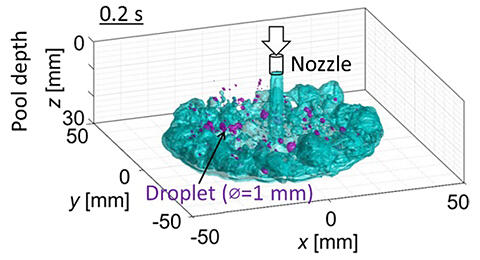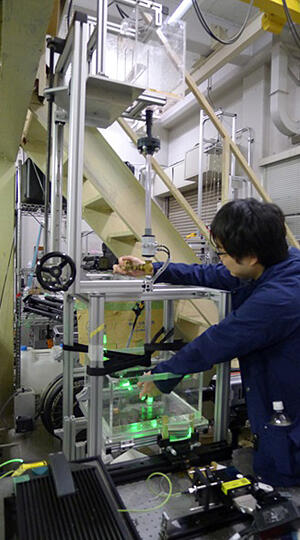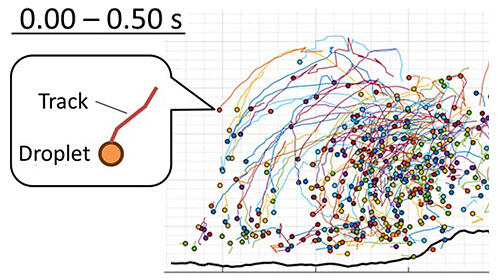A group including the Japan Atomic Energy Agency (JAEA) has revealed through simulated experiments that some of the molten fuel from a reactor damage accident can split into numerous tiny droplets when falling into a shallow water pool. Two patterns involving centrifugal force and gravity were observed. By understanding the formation process of fuel debris created by droplet solidification, they believe they can contribute to the most critical challenge of fuel debris retrieval at the Tokyo Electric Power Company's (TEPCO) Fukushima Daiichi Nuclear Power Plant.

Provided by JAEA
The reactor core at the Fukushima Daiichi Nuclear Power Plant was damaged by the tsunami during the 2011 Great East Japan Earthquake, causing the fuel to melt and fall to the bottom of the containment vessel. There was potentially a shallow spread of water at the bottom, but knowledge is limited about how the molten fuel spread afterward. Various scenarios were anticipated for the cooling and solidification process in water, such as the formation of numerous droplets or large masses. TEPCO conducted trial fuel debris retrieval in November 2024 and April of this year. Granular materials were observed, but the overall picture remains unclear.
Researcher Naoki Horiguchi who studies fluid engineering at JAEA's Nuclear Science and Engineering Center and his colleagues considered reproducing the scenario of molten fuel falling to the bottom of a shallow water pool using two different liquids. In around 2018, they reproduced a phenomenon of generating a large number of tiny droplets in the laboratory. They irradiated thin-film-like laser light and photographed the cross-section of a liquid with fluorescent dye but could not obtain three-dimensional data. Additionally, there was a problem where the different light refraction of the two liquids made the cross-section images unclear.

Provided by JAEA
To obtain clear three-dimensional data, Horiguchi and his team matched the refractive indices of the two liquids simulating molten fuel and water pool. Also, they incorporated, into the experimental equipment, a device that could continuously photograph cross-section images front and back by ingeniously using mirrors and lenses.

The exact size of the cracks through which molten fuel fell and the precise water depth at the bottom during the Fukushima Daiichi Nuclear Power Plant accident remain unknown. In the experiment, glycerol solution was dropped from a nozzle with an inner diameter of 5 mm into a tank containing silicon oil with a water depth of about 3 cm, and the spread of the solution was filmed for about a second. When the cross-section images were converted to three-dimensional data, the researchers found that numerous independent particles (droplets) were generated.

Provided by JAEA
By tracking the droplet generation process through images, two patterns were identified: "surfing pattern" and "liquid-film breaking pattern." In the former pattern, small waves rise in a vortex-like flow due to centrifugal force, and droplets collapse from the tip of the wave due to velocity differences between two liquids. In the latter pattern, vortex flows created by liquid lifted from the bottom separate due to gravity to form droplets.

Provided by JAEA
One flow of the process has been understood, where fuel that melted during a core damage accident splits finely and then cools and solidifies to become fuel debris. While there is a need to reproduce conditions expected in actual accidents, such as the amount and speed of fuel falling and water depth at the point of falling, this research provides insights for fuel debris retrieval work for decommissioning and is expected to contribute to improving nuclear reactor safety.
The research was conducted jointly with the University of Tsukuba and was published in the electronic version of the specialized fluid physics journal Physics of Fluids on March 10.
Original article was provided by the Science Portal and has been translated by Science Japan.




